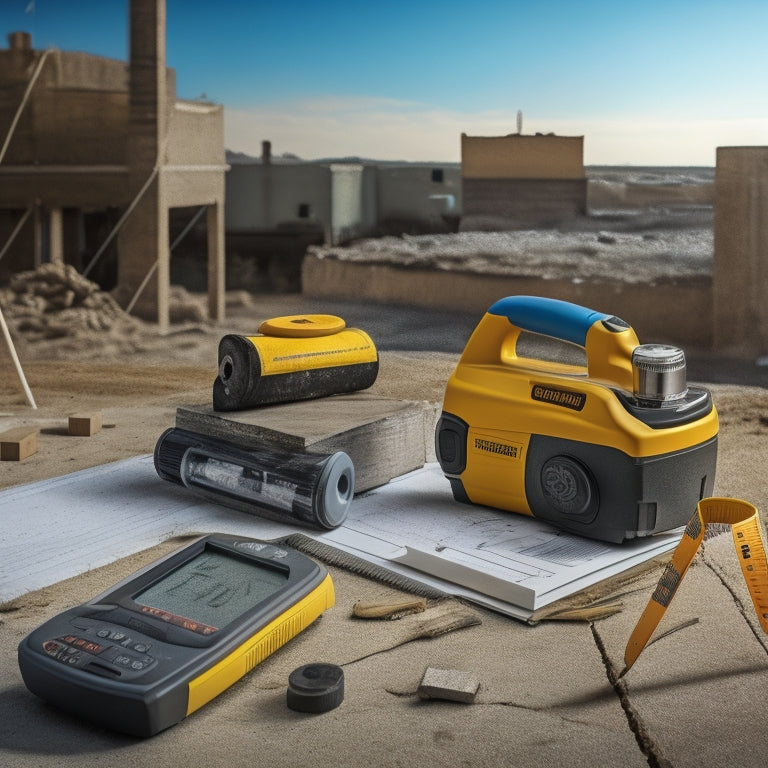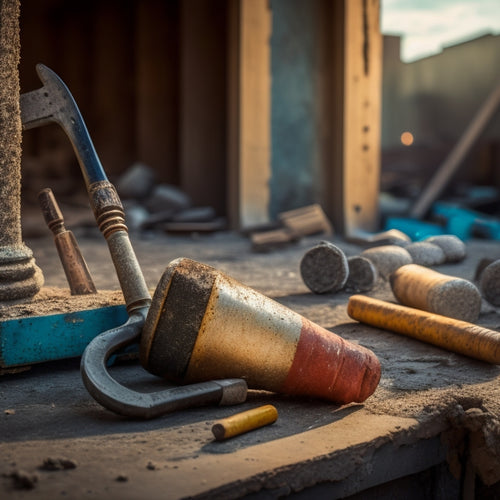
What Tools Do You Need for Concrete Inspection
Share
As a concrete inspector, you'll need a range of tools to accurately assess the integrity of concrete structures. Start with essential safety gear like hard hats, safety glasses, and respirators. Then, gather visual inspection equipment such as magnifying glasses, flashlights, and digital cameras. Measuring and testing tools like depth measurement devices and compression strength testing machines are also vital. Don't forget crack detection devices, surface preparation tools, and filling and finishing tools. Finally, utilize data recording and analysis software to track your findings. With these tools, you'll be well-equipped to conduct a thorough inspection - and a deeper understanding of each tool's application awaits.
Key Takeaways
• Essential safety gear, including hard hats, safety glasses, and respirators, is necessary for protecting inspectors on the job site.
• Visual inspection equipment like handheld magnifying glasses, high-quality flashlights, and digital cameras help identify surface irregularities and document findings.
• Measuring and testing tools, such as depth measurement devices and compression strength testing machines, provide accurate data on concrete properties.
• Crack detection devices, including acoustic emission testing and surface crack identification tools, help identify and quantify damage.
• Specialized tools for surface preparation, filling, finishing, curing, and sealing concrete are required to ensure successful repairs and inspections.
Essential Safety Gear
When conducting concrete inspections, you must wear essential safety gear to protect yourself from potential hazards, including falling debris, tripping hazards, and exposure to harsh chemicals. This isn't just a recommendation, but a necessity to guarantee your well-being on the job site.
As a concrete inspector, you're part of a community that prioritizes safety, and adhering to personal protective equipment (PPE) guidelines is vital. Your PPE should meet stringent safety standards, such as those outlined by the Occupational Safety and Health Administration (OSHA).
This includes wearing hard hats, safety glasses, earplugs, respirators, gloves, and steel-toed boots. These precautions will safeguard you against physical harm and long-term health risks.
Visual Inspection Equipment
You'll need a range of visual inspection equipment to examine concrete surfaces and identify potential defects or issues. This equipment helps you apply visual inspection techniques effectively, ensuring you don't miss any critical details.
A handheld magnifying glass or a precision telescope allows you to take a closer look at surface irregularities, cracks, or other anomalies. A high-quality flashlight or headlamp is also essential for illuminating areas with poor lighting, enabling you to spot defects that might be hidden in the shadows.
Additionally, consider investing in a digital camera or smartphone with a high-resolution camera. This will allow you to document your findings and create a visual record of the inspection. You can also use the camera to capture images of defects or issues, which can be useful for creating an inspection checklist or report.
Measuring and Testing Tools
When you're inspecting concrete, you'll need to measure and test its properties to guarantee it meets specifications.
You'll use devices to accurately determine the concrete's depth and test its compression strength to evaluate its overall quality.
Depth Measurement Devices
Measuring concrete depth accurately is essential, and that's where depth measurement devices come in, providing reliable data through non-destructive testing methods and precise readings.
When you're inspecting concrete, you need to know the exact depth to guarantee structural integrity and identify potential issues.
Depth measurement devices offer a range of options to suit your needs. For instance, laser depth measurement devices use laser technology to calculate the distance between the device and the concrete surface, providing accurate readings with minimal error.
On the other hand, ultrasonic measurement devices use high-frequency sound waves to determine the depth of the concrete. These devices are ideal for measuring depths in tight spaces or areas with complex geometries.
Both methods provide non-intrusive and non-destructive testing, allowing you to inspect concrete without causing damage.
Compression Strength Testing
Compression strength testing tools enable inspectors to accurately assess the compressive strength of concrete, a critical property that determines its load-bearing capacity and overall structural integrity. As an inspector, you need to verify that the concrete meets the required testing standards to guarantee the safety and durability of the structure.
Here are three essential compression strength testing tools you'll need:
-
Concrete compression testing machines: These machines apply a controlled amount of pressure to the concrete sample to measure its compressive strength.
-
Cube molds: You'll need these to cast concrete cubes, which are then tested for compressive strength using the testing machine.
-
Curing tanks: These tanks provide a controlled environment for the concrete samples to cure, verifying that they meet the testing standards.
Crack Detection Devices
When you're tasked with identifying cracks in concrete, you'll want to utilize specialized tools that can detect even the slightest fissures.
You'll find that acoustic emission testing is particularly effective in detecting cracks deep within the concrete, while surface crack identification methods allow you to visually inspect the surface for signs of damage.
Acoustic Emission Testing
You can use acoustic emission testing, a non-destructive testing method, to detect and locate cracks in concrete structures by identifying the high-frequency stress waves emitted by the material as it undergoes deformation or cracking.
This method allows you to assess the structural integrity of your concrete structure without causing any damage. Acoustic emission testing is particularly useful for monitoring the condition of critical infrastructure, such as bridges, dams, and high-rise buildings.
Here are three key benefits of using acoustic emission testing:
-
Real-time monitoring: You can monitor the structure's condition in real-time, allowing you to respond quickly to any changes or anomalies.
-
Early detection: Acoustic emission testing can detect cracks and defects at an early stage, enabling you to take corrective action before they become major problems.
-
Thorough evaluation: This method provides a thorough evaluation of the structure's condition, giving you a complete picture of its structural integrity.
Surface Crack Identification
Crack detection devices, specifically designed for surface crack identification, utilize advanced sensors and imaging technologies to visualize and quantify cracks on concrete surfaces. These devices help you detect even the smallest cracks, which is essential in preventing further crack propagation and ensuring the structural integrity of the concrete.
When selecting a crack detection device, consider the following factors:
| Device Type | Detection Method | Advantages |
|---|---|---|
| Acoustic Sensors | High-frequency sound waves | High accuracy, real-time results |
| Infrared Thermography | Temperature differences | Non-invasive, large-area scanning |
| Digital Imaging | High-resolution images | Detailed crack visualization, easy documentation |
Surface Preparation Tools
As you prepare to inspect concrete surfaces, it's vital to have the right tools for the job. Scalers, grinders, and sanders are essential surface preparation tools that enable you to effectively remove dirt, oil, and old coatings from concrete surfaces, ensuring a strong bond between the old and new materials.
When it comes to surface preparation techniques, you'll need to choose the right tool for the task at hand. Here are three must-haves:
-
Scalers: These tools are perfect for removing thick, heavy coatings and rough surfaces. They're ideal for surface repair methods that require a strong, aggressive approach.
-
Grinders: With their high-speed rotating blades, grinders are great for smoothing out rough surfaces and removing thin coatings. They're perfect for surface preparation techniques that require a high level of precision.
-
Sanders: These tools are designed for fine-tuning surfaces, removing small imperfections, and creating a smooth finish. They're ideal for surface repair methods that require a delicate touch.
Filling Material Calculators
When you're preparing for a concrete repair job, you'll need to calculate the right amount of filling material to guarantee a strong and durable bond.
You'll want to estimate the material quantity accurately to avoid waste and excess costs.
With a filling material calculator, you can quickly convert volumes and get precise estimates, saving you time and resources.
Material Quantity Estimates
Estimating the correct quantity of filling material is essential to confirm that your concrete repair project stays on track and within budget.
You can't afford to underestimate or overestimate the amount of material needed, as this can lead to costly delays or material waste.
To guarantee accuracy, you'll need to employ reliable material estimation techniques and quantity calculation methods.
Here are three essential tools to help you get it right:
-
Material calculation software: Utilize specialized software that can calculate the exact amount of filling material required based on the project's specifications.
-
Volume measurement tools: Leverage tools like calipers, measuring tapes, or laser distance meters to accurately measure the volume of the area that needs filling.
-
Material density charts: Refer to charts that provide the density of different filling materials, allowing you to calculate the correct quantity based on the material's density and the volume of the area.
Volume Conversion Tools
You'll need to accurately convert volume measurements to confirm you're ordering the correct amount of filling material, which is where filling material calculators come in. These tools are vital for concrete inspectors, as they enable you to calculate the exact volume of material required for a project. With filling material calculators, you can input the length, width, and height of the area that needs to be filled, and the calculator will provide you with the precise volume measurement.
To verify accuracy, it's important to understand various volume measurement techniques, such as calculating volume in cubic feet or cubic yards. Conversion formula applications also come into play, as you may need to convert between different units of measurement. For instance, you might need to convert square feet to cubic yards or vice versa.
Cleaning and Debonding Tools
Two essential tools in your concrete inspection arsenal are cleaning and debonding tools, which enable you to effectively prepare surfaces for testing and analysis.
You'll need these tools to remove dirt, grime, and other substances that can interfere with your test results. By investing in the right cleaning and debonding tools, you'll be able to guarantee accurate and reliable data.
Here are three must-have tools for cleaning and debonding:
-
Wire brushes: These are ideal for scrubbing away dirt and grime from concrete surfaces. You can choose from a variety of bristle lengths and stiffnesses to suit your specific needs.
-
Solvent-based cleaners: These are effective at removing oils, grease, and other substances that can affect bonding. Make sure to choose a cleaner that's compatible with the type of concrete you're working with.
-
Debonding agents: These are specialized chemicals that can help break the bond between old concrete and new concrete, making it easier to remove old material and prepare the surface for new applications.
Filling and Finishing Tools
Precision is essential when it comes to filling and finishing concrete surfaces, as even the slightest imperfection can compromise the integrity of the entire structure. You'll need the right tools to guarantee a smooth, even finish that meets the required standards.
Here are some essential filling and finishing tools you'll need:
| Tool | Description |
|---|---|
| Trowels | Used for applying and smoothing out filling materials, such as epoxy or polyurethane-based products. |
| Floats | Helps to achieve a smooth, even finish by removing excess material and air pockets. |
| Edgers | Designed for creating clean, sharp edges and corners, guaranteeing a professional-looking finish. |
| Grinders | Used to refine the surface, removing imperfections and achieving the desired texture. |
| Finishing Blades | Specialized blades for specific finishing techniques, such as grinding, polishing, or cutting. |
When selecting filling materials, consider the type of concrete, the desired finish, and the environmental conditions. You may need to choose between epoxy, polyurethane, or acrylic-based products, depending on the specific requirements of your project. By mastering various finishing techniques and selecting the right filling materials, you'll be able to achieve a high-quality finish that meets the required standards.
Curing and Sealing Tools
As a concrete inspector, you know that proper curing and sealing are essential to the success of any concrete project.
Most concrete projects require effective curing and sealing to prevent damage from environmental factors, guarantee durability, and enhance appearance. Inadequate curing and sealing can lead to cracks, discoloration, and reduced lifespan. To make certain of a successful project, you need the right tools for the job.
Here are three important curing and sealing tools you should have in your toolkit:
-
Curing compounds: These are applied to the concrete surface to prevent water loss and promote curing. You'll need to choose the right compound for your specific project, depending on factors like temperature, humidity, and desired finish.
-
Sealing sprayers: These are used to apply sealants to the concrete surface, protecting it from stains, damage, and wear. Look for sprayers that can handle the specific type and amount of sealant you're using.
-
Sealant testing kits: These kits allow you to test the effectiveness of your sealants, making sure they meet the required standards for your project.
Data Recording and Analysis
You'll need to accurately record and analyze data to verify that your curing and sealing efforts are meeting project specifications and ensuring the concrete's long-term performance. This involves collecting data on temperature, humidity, and other environmental factors that affect concrete curing and sealing. You'll also need to track the application rates, timings, and methods used for curing and sealing compounds.
Effective data management is essential in this process. You should consider using specialized software designed for concrete inspection data management. This will enable you to efficiently store, organize, and analyze your data.
Analytical software can help you identify trends, patterns, and correlations between different factors, allowing you to make informed decisions about your concrete inspection and maintenance strategies.
Frequently Asked Questions
Can I Use Concrete Inspection Tools for Other Construction Materials Too?
You're wondering if you can repurpose concrete inspection tools for other construction materials.
The answer is, it depends. While some tools are material-specific, others offer impressive cross-material applications.
Look for tool versatility, like scanners that can detect defects in wood, metal, or drywall, in addition to concrete.
How Often Should I Calibrate My Concrete Testing Equipment?
You're wise to wonder how often to calibrate your concrete testing equipment.
The calibration frequency directly impacts equipment accuracy, which is essential for reliable test results. Typically, you should calibrate your equipment every 3-6 months, or as specified by the manufacturer.
Additionally, calibrate after any significant repairs, exposure to harsh environments, or when you notice inconsistent results.
Are There Any Industry Standards for Concrete Inspection Reporting?
When you're preparing concrete inspection reports, you'll want to guarantee you're meeting industry standards.
You should familiarize yourself with industry regulations, such as ACI 318 and ASTM C1077, which provide guidelines for inspection reporting.
You'll need to include details like test methods, results, and observations.
Can I Perform Concrete Inspections During Extreme Weather Conditions?
When the storm clouds gather, don't let your concrete inspection plans get rained out.
You're probably wondering, can I still perform inspections during extreme weather conditions? The short answer is, it depends.
Prioritize inspection safety above all. If it's not safe for you or your team, reschedule.
But if you're prepared, you can still get the job done. Just be sure to follow industry guidelines and take necessary precautions to guarantee a safe and successful inspection.
Do I Need Special Training to Operate Concrete Inspection Tools?
You'll need to check the training requirements for operating concrete inspection tools, as they vary depending on the type of tool and the organization you're working with.
Typically, you'll need to complete a certification program or on-the-job training to guarantee you can operate the tools safely and effectively.
Don't assume you can just pick up a tool and start using it - proper training is essential to get accurate results and avoid accidents.
Conclusion
You've got the concrete inspection tools, now it's time to put them to use.
Don't think you can skip this step - improper concrete installation can lead to costly repairs and even safety hazards.
Yes, investing in these tools might seem like a significant upfront cost, but trust us, it's a fraction of what you'll save in the long run.
With the right tools, you'll guarantee a job well done and a safe, durable concrete structure that will last for years to come.
Related Posts
-

5 Best Tools for Stamping Concrete Walls
When it comes to stamping concrete walls, you'll need a range of specialized tools to achieve the desired texture and...
-

Why You Need These Concrete Overlay Tools
When tackling a concrete overlay project, you need the right tools to achieve a flawless finish and avoid costly mist...
-

5 Tips for Splitting Concrete With Second-Hand Tools
When splitting concrete with second-hand tools, you'll need to be strategic to avoid wasting time, money, and putting...


